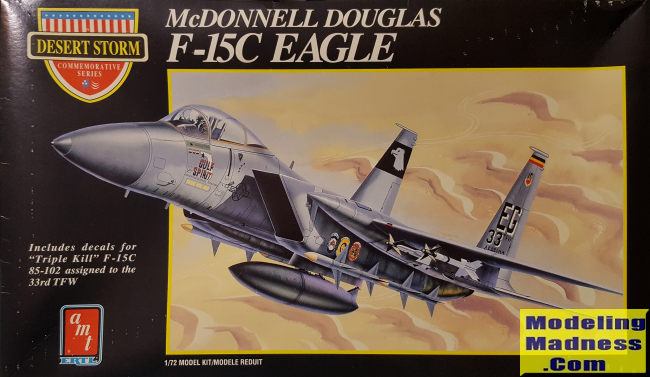
AMT 1/72 F-15C Eagle
| KIT #: | 8701 |
| PRICE: | $ |
| DECALS: | One option |
| REVIEWER: | Scott Van Aken |
| NOTES: | ESCI tooling. 1991 AMT release |

| HISTORY |
The F-15 prototype first flew in 1972 with production aircraft entering service in 1973 with FY 73 build aircraft at Luke AFB. At the time, it was the premier US fighter and a specially modified pre-production aircraft set many world records. Naturally, it caught the interest of allies who found the aircraft to be just what they wanted. As a result, the type has been in service with several other nations such as Japan, Saudi Arabia and Israel. Both Israel and Saudi Arabia have used their F-15s in combat as has the USAF.
As of this writing, the early F-15A/B aircraft have been retired from USAF service with many of the F-15C/Ds following. While the avionics in the remaining F-15C/D aircraft have been improved, the airframe has had a lot of hours on it and it is considered to be too expensive to perform major overhaul to replace fatigued airframe structure. Because of this, the type will probably be fully retired in a few years and replaced by the F-15X, which is being procured for the ANG. Many ANG F-15C/D units have either been disbanded or have switched to the F-16 due to the lack of viable airframes.
| THE KIT |
This particular kit was released in 1991 and has new decals to replace those of the earlier boxings. This was done to take advantage of the type's success in Gulf War I. The kit itself has the required engraved panel lines and is fairly typical of jet kits from the 1980s. There are a few spots on the sprues with a fair amount of flash, but it isn't a major issue. The cockpit has a fairly basic Aces II ejection seat and the instruments are represented by decals.
The fuselage is split horizontally with a single piece lower section and two piece upper portion. This is to allow for a possible two seat version to be done with minimal parts cost. Wings are a single upper piece with a lower wing insert. The wing pylon holes are already opened. The kit has Sidewinder missile rails and missiles. It has no long range fuel tanks. Intakes are fairly shallow with a portion of the first compressor stage provided as an insert.
 Fins
are separate with the upper fin ESM pod a separate piece. Stabs are also
separate and slot into the fuselage. Landing gear are well done and are sturdy.
There are only two options provided. One is an open or closed air brake and the
other is an open or closed canopy. Though not really that much of an option
unless you are using aftermarket decals, the kit does come with both early and
late burner cans.
Fins
are separate with the upper fin ESM pod a separate piece. Stabs are also
separate and slot into the fuselage. Landing gear are well done and are sturdy.
There are only two options provided. One is an open or closed air brake and the
other is an open or closed canopy. Though not really that much of an option
unless you are using aftermarket decals, the kit does come with both early and
late burner cans.
Instructions are well done with FS 595 color references. The aircraft is shown on the box art in the later Mod Eagle scheme. The decals are for the box art plane which is credited with three victories against fleeing Iraqi aircraft during Gulf War I. Decals include a ton of small stencils and they are fairly thick, but are quite usable, even after 30+ years.
| CONCLUSIONS |
This isn't a bad kit at all, though not anywhere near as well done as the newer kits from Fine Molds or even Hasegawa's toolings from the early 90. More in line with Hasegawa's initial F-15 kit, but with improved tooling and it actually has weapons. The lack of external fuel tanks is an odd omission as the planes were as likely to have them as not, but it isn't a deal breaker. Probably the best thing about this kit is that you can find it at a very reasonable price and it will make into a very nice model for your display.
September 2023
Copyright ModelingMadness.com. All rights reserved. No reproduction in part or in whole without express permission from the editor.
If you would like your product reviewed fairly and fairly quickly, please contact the editor or see other details in the Note to Contributors.
Back to the Main Page Back to the Review Index Page Back to the Previews Index Page